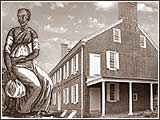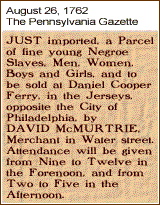ADDING SLAVES TO POMONA HALL
Historic Society Broadens Interpretation of Mansion Site

By Hoag Levins ...| ...May 4, 2003

CAMDEN, N.J. -- Although she visited to experience a light-hearted "Family Fun Day" at the Camden County Historical Society's Pomona Hall last Sunday, the New Jersey Secretary

|
| Photo: Hoag Levins |
Secretary of State Regena L. Thomas in the 18th-century parlor of Pomona Hall. The table is filled with period faux foods and an antique tea service.
|
of State ended her tour with a rumination on slavery.
Secretary Regena L. Thomas, who last summer walked the entire length of New Jersey tracing the path of the 19th-century Underground Railroad, was one of the first to visit the Society's newly-completed slavery records exhibit.
Slavery records
She spent another part of her visit in the parlor of Pomona Hall as president Richard Pillatt and director of programming Sandy Levins explained the Historical Society's recent refocus on the issue of 18th-century slavery in Camden County.
"I don't think most people know there were slave plantations in southern New Jersey," said Secretary Thomas in an interview afterwards. "And I think what the Camden County Historical Society is doing will appeal to a broader spectrum of visitors."
'Preserve our history'
"It is very important," the Secretary continued, "that we know and preserve our history, especially for the young people in our community. We don't have to dwell on the negative. To know that slaves occupied this land and its buildings and were able to keep it going, and that they spent every waking hour trying to get free should be an encouragement, particularly for urban Camden."
In the late 1700s, Pomona Hall was not only one of the region's grandest architectural landmarks, it was the headquarters of a plantation

|
| House Photo: Hoag Levins |
Pomona Hall was the 'Big House' of an 18th-century plantation worked by African slaves and indentured European servants. The period woodcut shows a female slave.
| that sprawled along Cooper River through what is now much of the neighborhood of Parkside. The plantation owner, Marmaduke Cooper, was a wealthy Quaker who was thrown out of that religious sect in 1780 for his refusal to free his slaves.
Slaves and servants
Records at the Historical Society indicate that Cooper's expansive fruit, crop and livestock plantation was manned by both African slaves and indentured European servants. The indentured servants sold themselves into bondage for a set period of time, most frequently to pay for their journey to America or cover other debts.
The Society has recently begun to publicly detail some of those 18th-century slave and indentured servant documents as part of an exhibit in a second floor gallery room of Pomona Hall.
Society president Pillatt has played a major role in implementing the quiet changes in how the mansion is explained to visitors.
'Rich, white English people'
"Years ago when I first became involved here, I was taught to give tours that were only about the rich, white English people who owned this property," Mr. Pillatt said. "There was nothing about the African slaves and poor white German and

|
| Photo: Hoag Levins |
Marmaduke Cooper's business documents detail his slaves and indentured servants. But most of the large cache of paperwork has not been analyzed or transcribed.
|
Dutch indentured servants who built and ran the plantation that supplied the owners' wealth.
"We knew something about the slaves but recently, museum curator Judith Snyder and Ms. Levins have turned up additional materials that begin to really bring Pomona Hall's slaves and indentured servants to life," he said.
Names of slaves
"For instance, we know some of the slaves' names," he continued. "We have the newspaper ads placed by Marmaduke Cooper offering rewards for the return of his runaways. Some ran away, were captured, and ran away again -- this certainly suggests something about their treatment and living conditions."
"The more we learn about Marmaduke Cooper," said Mr. Pillatt, who is an authority on 18th-century furnishings, "the more it is clear that he was a very cold fish who viewed his slaves and servants as merely another kind of livestock."
Typical of the period
"Now, the story we are trying to tell about Pomona Hall is that of an entire community of human beings -- some very rich and some very poor; some free, some held in bondage -- who lived and worked here in a manner typical of the period."
Pillatt noted that the Historical Society has "large amounts" of 18th-century paperwork from the Cooper plantation that have

|
A ferry landing at what is now Camden's tourist waterfront was used for slave auctions in the 18th-century. This is an actual newspaper ad from 1762.
| not been analyzed or transcribed and that that labor-intensive research project is high on the Society's list of priorities.
Mr. Pillatt noted that such research projects were one of a number of areas of the Historical Society's operations hard hit by the economic downturn as well as by cutbacks in funding.
'Why this place matters'
"When we started rethinking Pomona Hall," said Mr. Pillatt, "it was obvious that the slavery issue was an important part of why this place matters. It also potentially provided us with a way to work with a second local site -- the Peter Mott House Underground Railroad Museum in Lawnside -- in a synergistic way. Between us, we tell different sides of the same compelling story that is one of the key historical threads of American history."
"Aside from continuing our research into the Coopers' slave-era paperwork, we would like to try to learn if descendants of Pomona Hall slaves still live in the area. But all of this takes manpower and money and, at the moment, like other historical sites across the state, we're struggling through very difficult financial times."
~ ~ ~
| 


